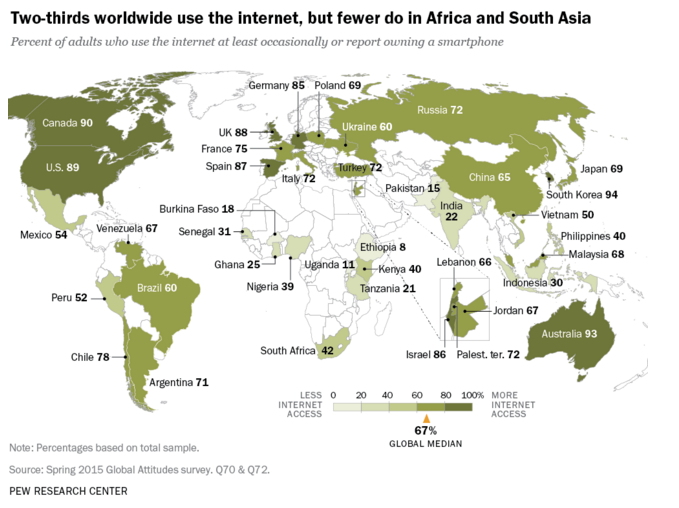Access to broadband internet service isn’t an issue for the vast majority of Canadians. Almost all Canadians have access to superfast broadband. Still, so many people focus on the “supply” side of the adoption calculation, rather than the much more difficult question of stimulating “demand”.
As a result, a number of articles attack the government for setting “unambitious” goals for its broadband strategy [Digital Canada 150, 3MB pdf], without understanding the real challenges of providing broadband service in rural markets (see “Rural broadband isn’t easy“).
There are companies making substantial investments to improve rural broadband coverage and service quality. The release of the 2500 MHz spectrum auction results last week saw millions of dollars being invested by Xplornet and Corridor Communications to improve the reach and speeds for their broadband services.
The biggest challenge restricting Canadians’ ability to participate meaningfully in the digital economy isn’t access to broadband, it is the question of affordability.
How do we determine what is affordable? Of course, we all want to pay less that what we are paying today. Affordability isn’t measured by what we want to pay, but more by what we are willing to pay. In the interests of rural and urban parity, people sometimes point to the prices being charged in urban markets as an appropriate target for affordable broadband service.
The problem is that there simply isn’t a “one size fits all” price point for universal broadband. Should a system of subsidies be set up to bring rural pricing down to urban levels? Such a “geographic-based” system appears to be premised on a belief that higher rural prices are not affordable. Equally, such a system also presumes that urban prices are, in fact, affordable to all.
Neither of these presumptions are supported by the data.
We continue to have a problem with broadband adoption in low-income households, whether urban or rural, despite government programs continuing to define digital adoption as a problem framed in terms of geography, not affordability.
The CRTC’s consultation launching a “Review of basic telecommunications services” examines the issue, but there is a risk that the consultation will also approach the problem with the same prejudice:
In phase 1, the Commission will review its policies regarding basic telecommunications services in Canada. The Commission will also gather information from the industry to better understand which telecommunications services are being offered across Canada and whether any areas in Canada are underserved or unserved.
The CRTC is starting with an examination of what areas might be underserved when it might be more useful to start by trying to understand “who in Canada is underserved or unserved”? The preamble of the consultation starts with a presumption that the problem is geographic, not based on any other factor. It is as though we are already asking about solutions for “where” before asking about “who” needs help.
In paragraph 3 of the Basic Service public notice, the CRTC acknowledges that Section 7 of the Telecom Act sets the following relevant policy objectives:
(b) to render reliable and affordable telecommunications services of high quality accessible to Canadians in both urban and rural areas in all regions of Canada; and
(h) to respond to the economic and social requirements of users of telecommunications services;
The Appendix to the public notice does in fact seek input in terms of economic requirements of users. The CRTC asks participants to “Identify and explain the barriers that limit or prevent Canadians from meaningfully participating in the digital economy (e.g. availability, quality, price, digital literacy, and concerns related to privacy and security). Identify which segments of the Canadian population are experiencing such barriers.”
However, in seeking public comments on solutions, we continue to see the terminology of a geographic bias. “What action, if any, should the Commission take where Canadians do not have access…” and “What action, if any, should the Commission take in cases where its target speeds will not be achieved…”
What evidence do we have that says “affordability” is a rural/urban issue? Why is there no discussion specifically seeking comments on the advisability of lifeline services [such as Lifeline Services described by the FCC] based on income?
When last produced, Statistics Canada showed that more than a quarter of households in Montreal had no internet use from home; the same was true for 1 in six households in Toronto and Vancouver; 1 in 5 in Regina.
Our telecom policy seeks to render affordable telecommunications services in both urban and rural areas in Canada, which requires substantially more information about economic and social factors that inhibit service adoption, in accordance with Section 7(h). Based on Statistics Canada’s information, there may be more Canadians in urban markets who are not subscribing to internet service than in rural markets.
Who are they and why are they not on-line?
Who will speak for the households that don’t have internet access?
The Commission says it “will consider what its role should be in ensuring the availability of basic telecommunications services, particularly in rural and remote regions of Canada.”
Before we answer the question about “where” the CRTC should be acting, perhaps we need to have a more clear understanding of “who” needs help and “why”.
We may need to find a solution that turns the current subsidy system upside down. Rather than subsidizing the “where”, has anyone looked at providing subsidies directly to those who need it?
Update: [May 19, 7:45 am]
An article today at AEI’s Tech Policy Daily by Bronwyn Howell looks at “The rural-urban divide on broadband adoption and pricing: Fact or fiction?” from an econometric perspective. “The bottom line is that broadband adoption is complicated, and that price is only one of its many determinants. When regulators are facing a problem where the root causes are ill-defined (or perhaps the problem is even non-existent and simply a statistics-mirage), a high degree of regulatory humility becomes important.”


 Bell Canada has
Bell Canada has